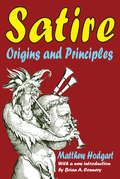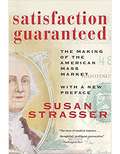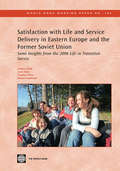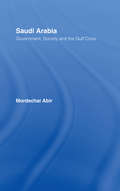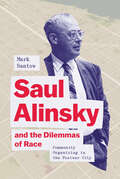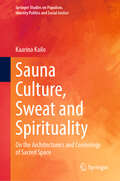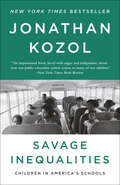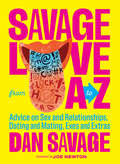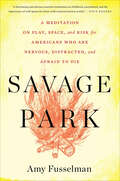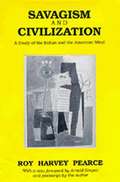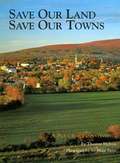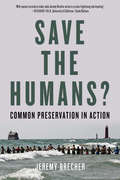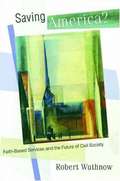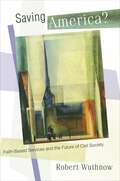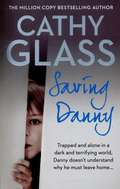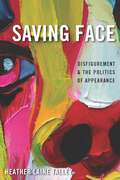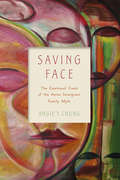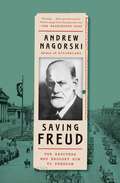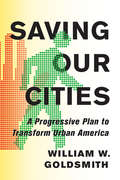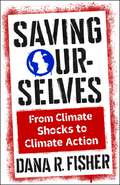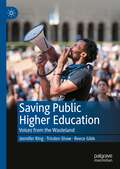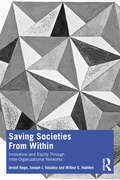- Table View
- List View
Satire: Origins and Principles
by Matthew HodgartSatire, according to Jonathan Swift, is a mirror where beholders generally discover everybody's face but their own. and over twenty-four centuries the mirror of satirical literature has taken on many shapes. Yet certain techniques recur continually, certain themes are timeless, and some targets are perennial. Politics (the mismanagement of men by other men) has always been a target of satire, as has the war between sexes.The universality of satire as a mode and creative impulse is demonstrated by the cross-cultural development of lampoon and travesty. Its deep roots and variety are shown by the persistence of allegory, fable, aphorism, and other literary subgenres. Hodgart analyzes satire at some of its most exuberant moments in Western literature, from Aristophanes to Brecht. His analysis is supplemented by a selection and discussion of prints and cartoons.Satire continues to help us make sense of the conventions that seem to have been almost genetically transmitted from their satiric ancestors to our digital contemporaries. This is especially evident in Hodgart's repeated references to satire's predilection for the ephemeral, for camouflaging itself among the everyday, for speaking to the moment, and thus for integrating itself as deeply as possible into society. Brian Connery's new introduction places Hodgart's analysis in its proper place in the development of twentieth-century criticism.
Satisfaction Guaranteed: The Making Of The American Mass Market
by Susan StrasserThis sweeping history provides the reader with a better understanding of America’s consumer society, obsession with shopping, and devotion to brands. Focusing on the advertising campaigns of Coca-Cola, Kellogg’s, Wrigley’s, Gillette, and Kodak, Strasser shows how companies created both national brands and national markets. These new brands eventually displaced generic manufacturers and created a new desire for brand-name goods. The book also details the rise and development of department stores such as Macy’s, grocery store chains such as A&P and Piggly Wiggly, and mail-order companies like Sears Roebuck and Montgomery Ward.
Satisfaction with Life and Service Delivery in Eastern Europe and the Former Soviet Union
by Pradeep K. Mitra Salman Zaidi Asad Alam Ramya SundaramThe past two decades in Eastern Europe and the former Soviet Union have been times of tremendous change, with countries undergoing rapid transformation from centrally-planned to market-oriented economies. While poverty increased during the initial years of transition, primarily on account of the sharp economic contraction, the resurgence of economic growth in the region since 1998 has resulted in a rebound in household incomes and living standards. Data from the 2006 Life in Transition Survey (LiTS)-a joint initiative of the European Bank for Reconstruction and Development and the World Bank-provides a unique opportunity to investigate the extent to which citizens of ECA countries are satisfied with their lives and with the performances of their governments, and to study key factors influencing their outlook in a systematic way across all countries of the region. The main objective of the LiTS was to assess the impact of transition on people, covering four main themes. First, it collected personal information on aspects of material well-being, including household expenditures, possession of consumer goods such as a car or mobile phone, and access to local public services and utilities. Second, the survey included measures of satisfaction and attitudes towards economic and political reforms as well as public service delivery. Third, the LiTS captured individual 'histories'-key events and episodes that may have influenced their attitudes towards reforms, and information on family background, employment, and coping strategies. Finally, the survey also attempted to capture the extent to which crime and corruption are affecting peoples' lives, and the extent to which individuals' trust in other people and in state institutions has changed over time.
Saudi Arabia in Transition
by Bernard Haykel Bernard Haykel Thomas Hegghammer Stéphane Lacroix Thomas HegghammerMaking sense of Saudi Arabia is crucially important today. The kingdom's western province contains the heart of Islam, its two holiest mosques in Mecca and Medina, and it is the United States' closest Arab ally and the largest producer of oil in the world. However, the country is undergoing rapid change: its aged leadership is ceding power to a new generation, and its society, which is dominated by young people, is restive. Saudi Arabia has long remained closed to foreign scholars, with a select few academics allowed into the kingdom over the past decade. This book presents the fruits of their research as well as those of the most prominent Saudi academics in the field. The fifteen chapters in this volume focus on different sectors of Saudi society and examine how the changes of the past few decades have affected each. Many of the authors have conducted archival and fieldwork research in Saudi Arabia, benefitting from the recent opening of the country to foreign researchers. As such, the volume reflects new insights and provides the most up-to-date research on the country's social, cultural, economic and political dynamics.
Saudi Arabia: Society, Government and the Gulf Crisis
by Mordechai AbirThis much-revised edition of Professor Abir's Saudi Arabia in the Oil Era now includes consideration of both Gulf Wars. Abir examines the social and political forces that have shaped Saudi Arabia, including the impact of Islam and of Westernization, drawing heavily on Saudi sources. There is also essential analysis of regional security dilemmas and of the country's prospects in the post-Gulf War era.
Saul Alinsky and the Dilemmas of Race: Community Organizing in the Postwar City
by Mark SantowA groundbreaking examination of Saul Alinsky's organizing work as it relates to race. Saul Alinsky is the most famous—even infamous—community organizer in American history. Almost single-handedly, he invented a new political form: community federations, which used the power of a neighborhood’s residents to define and fight for their own interests. Across a long and controversial career spanning more than three decades, Alinsky and his Industrial Areas Foundation organized Eastern European meatpackers in Chicago, Kansas City, Buffalo, and St. Paul; Mexican Americans in California and Arizona; white middle-class homeowners on the edge of Chicago’s South Side black ghetto; and African Americans in Rochester, Buffalo, Chicago, and other cities. Mark Santow focuses on Alinsky’s attempts to grapple with the biggest moral dilemma of his age: race. As Santow shows, Alinsky was one of the few activists of the period to take on issues of race on paper and in the streets, on both sides of the color line, in the halls of power, and at the grassroots, in Chicago and in Washington, DC. Alinsky’s ideas, actions, and organizations thus provide us with a unique and comprehensive viewpoint on the politics of race, poverty, and social geography in the United States in the decades after World War II. Through Alinsky’s organizing and writing, we can see how the metropolitan color line was constructed, contested, and maintained—on the street, at the national level, and among white and black alike. In doing so, Santow offers new insight into an epochal figure and the society he worked to change.
Sauna Culture, Sweat and Spirituality: On the Architectonics and Cosmology of Sacred Space (Springer Studies on Populism, Identity Politics and Social Justice)
by Kaarina KailoThis book explores spiritual and sacred practices in Finnish saunas and Native North American sweat lodges through a comparative study. It also sheds light on ancient traditions from Ireland and Galicia, tracing their evolution and shared spiritual features. The book further analyzes gendered rituals, woman-centered lifeways, and cyclical worldviews rooted in rebirth and regeneration. This book shows how these practices reflect a deep, cross-cultural matrix of symbols celebrating Heaven and Earth. It presents the Delaware Sweat Lodge and Big House as prototypes of sacred structures for world renewal and their connections to sauna cultures worldwide. By defining key concepts from patriarchal, feminist, and Indigenous perspectives, this book challenges normative, unquestioned notions of the sacred and the divine. The book's interdisciplinary approach will appeal to students, scholars, and researchers of gender studies, Indigenous studies, cultural studies, religious studies, philosophy, and anthropology interested in a better understanding of how ancient rituals hold ecological significance for addressing today&’s planetary crises and social imbalances, revealing like-mindedness across diverse faith traditions.
Savage Inequalities: Children in America's Schools
by Jonathan KozolFor two years, beginning in 1988, Jonathan Kozol visited schools in neighborhoods across the country, from Illinois to Washington D.C., and from New York to San Antonio. He spoke with teachers, principals, superintendents, and, most important, children. What he found was devastating. Not only were schools for rich and poor blatantly unequal, the gulf between the two extremes was widening—and it has widened since. The urban schools he visited were overcrowded and understaffed, and lacked the basic elements of learning—including books and, all too often, classrooms for the students. <P><P> In Savage Inequalities, Kozol delivers a searing examination of the extremes of wealth and poverty and calls into question the reality of equal opportunity in our nation’s schools.
Savage Love from A to Z: Advice on Sex and Relationships, Dating and Mating, Exes and Extras
by Dan SavageAmerica's premier sex advice columnist takes on edgier-than-ever sex-positive topics with his signature candor in his first illustrated collection of adults-only essays, coinciding with the 30th anniversary of the Savage Love column. Dan Savage has been talking frankly about sex and relationships for 30 years, and has built an international following thanks to his sex-positive Savage Love column and podcast. To celebrate this milestone comes Savage Love from A to Z, an illustrated collection of 26 never-before-published essays that provides a thoughtful, frank dive into Savage's trademark phrases and philosophies. This hardcover book is for anyone who's had sex, is currently having sex, or hopes to have sex!Essays cover a variety of topics: • B Is for Boredom • F Is for Fuck First • G Is for GGG (Good Giving Game) • M Is for MonogamishWhether he's talking about issues like compatibility or specific sex acts, you can be sure he's giving it to you straight. Short excerpts from his classic columns kick off each essay and cheeky illustrations by his longtime collaborator Joe Newton complement the topic at hand. Savage has moved the needle toward a more open discourse around sex, relationships, and intimacy, and this book will both inspire and inform his legions of fans. An ideal stocking stuffer!
Savage Park: A Meditation on Play, Space, and Risk for Americans Who Are Nervous, Distracted, and Afraid to Die
by Amy Fusselman"A fascinating and daresay essential meditation on childhood, parenthood, and the importance of wild spaces for those wild creatures known as kids."—Dave Eggers How fully can the world be explored when you are focused on trying not to die? This is the question that lies at the heart of Amy Fusselman&’s Savage Park. America is the land of safety, of protecting children to make sure that nothing can possibly hurt them. But while on a trip to Tokyo with her family, Fusselman stumbled upon an adventure playground called Hanegi Playpark, where children sawed wood, hammered nails, and built open fires. Her conceptions of space, risk, and play were shattered. In asking us to reexamine fundamental ideas about our approaches to space and risk and how we pass these concepts down to our children, Fusselman also asks us to look at the world in a different way. Perhaps it isn&’t variety, but fear that is the spice of life. This startling revelation is at the heart of Savage Park, and will make readers look at the world in a whole new way. &“I yield to no one in my admiration for Amy Fusselman&’s work. Her new book, Savage Park, further explores with astonishing power, eloquence, precision, and acid humor her obsessive, necessary theme: the gossamer-thin separation between life and death.&” —David Shields, author of Reality Hunger &“In this unusually refreshing meditation (which reads like a novel), we are given a tour of the space around and within us. With poetic efficiency Amy Fusselman reveals what makes us savage or not; why secret, wild spaces are essential; and why playing should be taken seriously.&” —Philippe Petit, high-wire artist
Savagism and Civilization: A Study of the Indian and the American Mind
by Roy Harvey PearceFirst published in 1953, revised in 1964, and presented here with a new foreword by Arnold Krupat and new postscript by the author, Roy Harvey Pearce's "Savagism and Civilization" is a classic in the genre of history of ideas. Examining the political pamphlets, missionaries' reports, anthropologists' accounts, and the drama, poetry, and novels of the 18th and early 19th centuries, Professor Pearce traces the conflict between the idea of the noble savage and the will to Christianize the heathen and appropriate their land, which ended with the near extermination of Native American culture.
Save Our Land, Save Our Towns: A Plan For Pennsylvania
by Thomas Hylton Blair SeitzPulitzer Prize-winning jounalist Thomas Hylton outlines in a readable style with Seitz's award-winning photography a plan for Pennsylvania - or any state - to preserve farmland and forests, and revive our cities and neighborhoods - as well as lower our cost of living. Winner of National Trust for Historic Preservation award.
Save the Bees!
by Lisa Jean Moore Mary KosutGrappling with the strange phenomenon of colony collapse disorder--the baffling disappearance of all bees from a hive that is often blamed for the honeybee's increasingly endangered status--New York City's hobbyist beekeeping communities have gone green. Lisa Jean Moore and Mary Kosut introduce beekeepers of all stripes: the careful cultivators of 'scientific' beekeeping groups, the passionately political radical 'backwards' beekeepers who hope to return the species to its most natural state, and DIY-influenced 'hipster' beekeepers who share a holistic approach to lowering their environmental impact. Though their approaches may differ, these beekeepers agree on one thing: to save the bee is to save our planet.
Save the Humans?: Common Preservation in Action
by Jeremy BrecherWe the people of the world are creating the conditions for our own self-extermination, whether through the bang of a nuclear holocaust or the whimper of an expiring ecosphere. Today our individual self-preservation depends on common preservation—cooperation to provide for our mutual survival and well-being. For half a century Jeremy Brecher has been studying and participating in social movements that have created new forms of common preservation. Brecher traces a path that leads from the sitdown strikes on the pyramids of ancient Egypt through America's mass strikes and labor revolts to the struggle against economic globalization to today's battles against climate change. Weaving together personal experience, scholarly research, and historical interpretation, Jeremy Brecher shows how we can construct a "human survival movement" that could "save the humans." He sums up the theme of this book: "I have seen common preservation—and it works." For those seeking an understanding of social movements and an alternative to denial and despair, there is simply no better place to look than Save the Humans?
Saving America: Faith-Based Services and the Future of Civil Society
by Robert WuthnowThe author discusses whether congregations are effective vehicles for providing broad-based social programs and whether they are actually fostering the civil society.
Saving America?: Faith-Based Services and the Future of Civil Society
by Robert WuthnowOn January 29, 2001, President George W. Bush signed an executive order creating the White House Office of Faith-Based and Community Initiatives. This action marked a key step toward institutionalizing an idea that emerged in the mid-1990s under the Clinton administration--the transfer of some social programs from government control to religious organizations. However, despite an increasingly vocal, ideologically charged national debate--a debate centered on such questions as: What are these organizations doing? How well are they doing it? Should they be supported with tax dollars?--solid answers have been few. In Saving America? Robert Wuthnow provides a wealth of up-to-date information whose absence, until now, has hindered the pursuit of answers. Assembling and analyzing new evidence from research he and others have conducted, he reveals what social support faith-based agencies are capable of providing. Among the many questions he addresses: Are congregations effective vehicles for providing broad-based social programs, or are they best at supporting their own members? How many local congregations have formal programs to assist needy families? How much money do such programs represent? How many specialized faith-based service agencies are there, and which are most effective? Are religious organizations promoting trust, love, and compassion? The answers that emerge demonstrate that American religion is helping needy families and that it is, more broadly, fostering civil society. Yet religion alone cannot save America from the broad problems it faces in providing social services to those who need them most. Elegantly written, Saving America? represents an authoritative and evenhanded benchmark of information for the current--and the coming--debate.
Saving Danny
by Cathy GlassDanny was petrified and clung to me in desperation as I carried him to my car. Trapped in his own dark world, he couldn't understand why his parents no longer loved or wanted him, and were sending him away. While Danny's parents have everything they could wish for in material terms, they are unable to care for their only child. This is where Cathy comes in. On a cold dark evening Danny finds a place in her home where he can be himself; away from his parents' impatience and frustration. Often in his own little world, six-year-old Danny finds it difficult to communicate, finding solace in his best friend and confidant George - his rabbit. Cathy quickly becomes aware of his obsessively meticulous behaviour in addition to his love of patterns, he sees them everywhere and creates them at any opportunity - in his play and also with his food. She realises that patience is the key to looking after Danny as well as her well-tried strategies for managing children's behaviour. With his father refusing to cooperate, it becomes increasingly likely that Danny will be living with Cathy permanently until she gets an opportunity to speak her piece.
Saving Face: Disfigurement and the Politics of Appearance
by Heather Laine TalleyWinner, Body and Embodiment Award presented by the American Sociological AssociationImagine yourself without a face—the task seems impossible. The face is a core feature of our physical identity. Our face is how others identify us and how we think of our ‘self’. Yet, human faces are also functionally essential as mechanisms for communication and as a means of eating, breathing, and seeing. For these reasons, facial disfigurement can endanger our fundamental notions of self and identity or even be life threatening, at worse. Precisely because it is so difficult to conceal our faces, the disfigured face compromises appearance, status, and, perhaps, our very way of being in the world.In Saving Face, sociologist Heather Laine Talley examines the cultural meaning and social significance of interventions aimed at repairing faces defined as disfigured. Using ethnography, participant-observation, content analysis, interviews, and autoethnography, Talley explores four sites in which a range of faces are “repaired:” face transplantation, facial feminization surgery, the reality show Extreme Makeover, and the international charitable organization Operation Smile,. Throughout, she considers how efforts focused on repair sometimes intensify the stigma associated with disfigurement. Drawing upon experiences volunteering at a camp for children with severe burns, Talley also considers alternative interventions and everyday practices that both challenge stigma and help those seen as disfigured negotiate outsider status.Talley delves into the promise and limits of facial surgery, continually examining how we might understand appearance as a facet of privilege and a dimension of inequality. Ultimately, she argues that facial work is not simply a conglomeration of reconstructive techniques aimed at the human face, but rather, that appearance interventions are increasingly treated as lifesaving work. Especially at a time when aesthetic technologies carrying greater risk are emerging and when discrimination based on appearance is rampant, this important book challenges us to think critically about how we see the human face.
Saving Face: How to Preserve Dignity and Build Trust
by Maya Hu-Chan"Maya Hu-Chan shares a blueprint for becoming a more empathetic, self-aware, and inclusive leader. Saving Face guides us to consider different perspectives, to think first and speak last, and to respect others above all else."—Frances Hesselbein, former CEO, Girl Scouts of the USA, and Presidential Medal of Freedom recipientOrganizations now need to attract, retain, and motivate teams and employees across distance, time zones, and cultural differences. Building authentic and lasting human relations may be the most important calling for leaders in this century. According to management and global leadership specialist Maya Hu-Chan, the concept of "saving face" can help any leader preserve dignity and create more empathetic cross-cultural relationships. "Face" represents one's self-esteem, self-worth, identity, reputation, status, pride, and dignity. Saving face is often understood as saving someone from embarrassment, but it's also about developing an understanding of the background and motivations of others to discover the unique facets we all possess. Without that understanding, we risk causing others to lose face without even knowing it. Hu-Chan explains saving face through anecdotes and practical tools, such as her BUILD leadership model (Benevolence, Understanding, Interacting, Learning, and Delivery). This book illustrates how we can give face to create positive first impressions, avoid causing others to lose face, and, most importantly, build trust and lasting relationships inside and outside the workplace.
Saving Face: The Emotional Costs of the Asian Immigrant Family Myth
by Angie Y. ChungTiger Mom. Asian patriarchy. Model minority children. Generation gap. The many images used to describe the prototypical Asian family have given rise to two versions of the Asian immigrant family myth. The first celebrates Asian families for upholding the traditional heteronormative ideal of the "normal (white) American family" based on a hard-working male breadwinner and a devoted wife and mother who raises obedient children. The other demonizes Asian families around these very same cultural values by highlighting the dangers of excessive parenting, oppressive hierarchies, and emotionless pragmatism in Asian cultures.<P><P> Saving Face cuts through these myths, offering a more nuanced portrait of Asian immigrant families in a changing world as recalled by the people who lived them first-hand: the grown children of Chinese and Korean immigrants. Drawing on extensive interviews, sociologist Angie Y. Chung examines how these second-generation children negotiate the complex and conflicted feelings they have toward their family responsibilities and upbringing. Although they know little about their parents' lives, she reveals how Korean and Chinese Americans assemble fragments of their childhood memories, kinship narratives, and racial myths to make sense of their family experiences. However, Chung also finds that these adaptive strategies come at a considerable social and psychological cost and do less to reconcile the social stresses that minority immigrant families endure today.<P> Saving Face not only gives readers a new appreciation for the often painful generation gap between immigrants and their children, it also reveals the love, empathy, and communication strategies families use to help bridge those rifts.
Saving Freud: The Rescuers Who Brought Him to Freedom
by Andrew NagorskiA dramatic true story about Sigmund Freud&’s last-minute escape to London following the German annexation of Austria and the group of friends who made it possible.In March 1938, German soldiers crossed the border into Austria and Hitler absorbed the country into the Third Reich. Anticipating these events, many Jews had fled Austria, but the most famous Austrian Jew remained in Vienna, where he had lived since early childhood. Sigmund Freud was eighty-one years old, ill with cancer, and still unconvinced that his life was in danger. But several prominent people close to Freud thought otherwise, and they began a coordinated effort to persuade Freud to leave his beloved Vienna and emigrate to England. The group included a Welsh physician, Napoleon&’s great-grandniece, an American ambassador, Freud&’s devoted youngest daughter Anna, and his personal doctor. Saving Freud is the story of how this remarkable collection of people finally succeeded in coaxing Freud, a man who seemingly knew the human mind better than anyone else, to emerge from his deep state of denial about the looming catastrophe, allowing them to extricate him and his family from Austria so that they could settle in London. There Freud would live out the remaining sixteen months of his life in freedom. This book is both an incisive new biography of Freud and a group biography of the extraordinary friends who saved Freud&’s life.
Saving Our Cities: A Progressive Plan to Transform Urban America
by William W. GoldsmithIn Saving Our Cities, William W. Goldsmith shows how cities can be places of opportunity rather than places with problems. With strongly revived cities and suburbs, working as places that serve all their residents, metropolitan areas will thrive, thus making the national economy more productive, the environment better protected, the citizenry better educated, and the society more reflective, sensitive, and humane.Goldsmith argues that America has been in the habit of abusing its cities and their poorest suburbs, which are always the first to be blamed for society's ills and the last to be helped. As federal and state budgets, regulations, and programs line up with the interests of giant corporations and privileged citizens, they impose austerity on cities, shortchange public schools, make it hard to get nutritious food, and inflict the drug war on unlucky neighborhoods.Frustration with inequality is spreading. Parents and teachers call persistently for improvements in public schooling, and education experiments abound. Nutrition indicators have begun to improve, as rising health costs and epidemic obesity have led to widespread attention to food. The futility of the drug war and the high costs of unwarranted, unprecedented prison growth have become clear. Goldsmith documents a positive development: progressive politicians in many cities and some states are proposing far-reaching improvements, supported by advocacy groups that form powerful voting blocs, ensuring that Congress takes notice. When more cities forcefully demand enlightened federal and state action on these four interrelated problems—inequality, schools, food, and the drug war—positive movement will occur in traditional urban planning as well, so as to meet the needs of most residents for improved housing, better transportation, and enhanced public spaces.<
Saving Ourselves: From Climate Shocks to Climate Action (Society and the Environment)
by Dana R. FisherWe've known for decades that climate change is an existential crisis. For just as long, we've seen the complete failure of our institutions to rise to the challenge. Governments have struggled to meet even modest goals. Fossil fuel interests maintain a stranglehold on political and economic power. Even though we have seen growing concern from everyday people, civil society has succeeded only in pressuring decision makers to adopt watered-down policies. All the while, the climate crisis worsens. Is there any hope of achieving the systemic change we need?Dana R. Fisher argues that there is a realistic path forward for climate action—but only through mass mobilization that responds to the growing severity and frequency of disastrous events. She assesses the current state of affairs and shows why public policy and private-sector efforts have been ineffective. Spurred by this lack of progress, climate activism has become increasingly confrontational. Fisher examines the radical flank of the climate movement: its emergence and growth, its use of direct action, and how it might evolve as the climate crisis worsens. She considers when and how activism is most successful, identifying the importance of creating community, capitalizing on shocking moments, and cultivating resilience. Clear-eyed yet optimistic, Saving Ourselves offers timely insights on how social movements can take power back from deeply entrenched interests and open windows of opportunity for transformative climate action.
Saving Public Higher Education: Voices from the Wasteland
by Jennifer Ring Trisden Shaw Reece GibbIn this book, eleven recent college graduates describe in vivid detail their journeys from racially segregated, underfunded public schools to a state university, and the obstacles they encountered along the way. Chapters highlight personal accounts of poverty, violence, and bullying in childhood, the persistence of racism on the university campus and the inability of faculty and administrators to combat it. Overcoming all-too-common barriers, these eleven students persevered, earned their degrees and continued on to graduate school and professional careers. The authors conclude the book with policy proposals that not only address the issues raised by the students, but that would also restore public education to its original role as an engine of opportunity and driver of democracy.
Saving Societies From Within: Innovation and Equity Through Inter-Organizational Networks
by Jerald Hage Joseph J. Valadez Wilbur C. HaddenMoving beyond existing models from economics and political science, this book shows how crises in capitalism and democracy can be solved with Systemic coordinated inter-organizational networks.It offers a new model of societal coordination that builds cooperation and trust while solving today’s modern and complex practical problems: Systemic coordinated inter-organizational networks (SCIONs). It details how SCIONs can quickly catalyze organizational change among interorganizational network members while providing a general framework for characterizing individual and organizational change. The chapters apply these theoretical ideas in an epic case study of the rebuilding of the health care system in rural Nicaragua after a major natural disaster (Hurricane Mitch). They provide lessons for public health program managers while contributing to the literatures on modes of coordination and on social capital.The book is a vital text for upper-division courses on management, inter-organizational collaboration, crisis management and public health.
